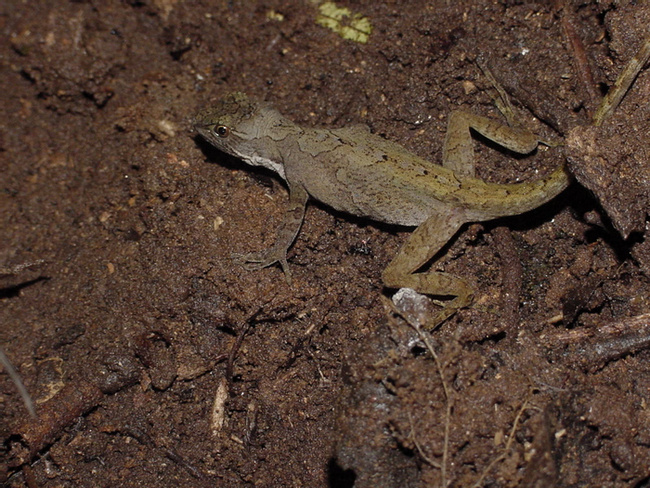
More about Ground Anole
Habitat
This lizard prefers shady areas on the forest floor or near the base of large trees, particularly ones with large buttresses holding deep leaf litter. The ground anole can live in virgin rainforest as well as overgrown cacao plantations; lowland to premontane to lower montane zones; and moist to wet to rainforest.
Range
From eastern and southern Honduras down to central Panama, this animal can live from 2 to 1,500 m in elevation.
Physical Description
A small brown lizard, Norops humilis can have a broad dark band down its back and a lighter brown underside. The eyes are a bronze-speckled light brown. Males have a dewlap—an flap of skin on the throat—that is bright orange in this species. Other species have differently colored dewlaps. Females do not have a dewlap, although they may still have a patch of reddish skin on the throat; they might have a white stripe or row of spots on the back as well.
This lizard has a deep axillary pore or pocket in the armpit of each front leg. This pore is inhabited by parasitic mites.
Biology and Natural History
There are 21 species of Norops lizards in Costa Rica and 7 live in the southwestern region. This species, Norops humilis, is the most likely to be seen. An abundant, small, arboreal creature, N. humilis is diurnally active and commonly glimpsed perching on tree trunks, tree buttresses, or deep leaf litter on the forest floor. This is not basking behavior like other lizards—this species is a thermoconformer, and maintains its body temperature without relying on taking sun and shade. When perching, one often clings to the bark of a tree about 1.5 m off the ground with its head pointed down. When startled, this lizard will take an evasive route before diving under the leaf litter.
Much of the day’s energy is spent searching for prey. From its perch, the anole watches the leaf litter for small invertebrates, sprints after them, and returns to the perch. They may eat as often as once an hour. Nearly all of a female’s energy is spent looking for food. Males are more preoccupied with social behaviors, particularly defending territory and attracting females. Males therefore perch higher off the ground than females. An adult male spends several hours of his day showing off his dewlap. He stretches out the dewlap, and bobs his head up and down. If this display coincides with a female’s entrance into his territory, the male will court her by flashing his dewlap just for her before chasing her across the forest floor. If another male is bold enough to intrude, the resident male’s display may escalate to chasing and biting. A male is fiercely territorial towards other males to ensure his access to the females (1 to 3) that overlap his territory. A female defends her territory solely to ensure food supply.
Rainfall brings an increase in courtship and reproduction, although these lizards may mate all year. A female will lay one large egg once a week through the rainy season, and once every two weeks in the dry. This ability to reproduce so often is one reason this lizard is prolific in the forests of Costa Rica. Few norops lizards live longer than a year. They are common prey for many larger animals, from larger lizards, vine snakes (and other serpents), to motmots and trogons. Young, small anoles become food for large invertebrates, such as mantids and katydids.
Diet
Norops eat quite the variety of arthropods, including but not limited to spiders, cockroaches, crickets, caterpillars, beetles, flies, termites, hemipterans, and centipedes. They do not like ants.
Height/Weight
An average total length for this species is 114 mm, the snout-vent portion of which is 40 mm. The tail is approximately 60% of its total length. Females tend to be smaller than males by a few millimeters.
Taxonomy
Order: Squamata
Family: Iguanidae
*Note: The taxonomical categorization of this species is currently debated.
Sources
Andrews, R. M. in: Janzen, Daniel H. Costa Rican Natural History. Chicago: University of Chicago Press, 1983.
Leenders, Twan. A Guide to Amphibians and Reptiles of Costa Rica. Zona Tropical, S.A, Miami, FL, 2001.
Savage, Jay M. The Amphibians and Reptiles of Costa Rica: A Herpetofauna between two Continents, between Two Seas. The University of Chicago Press, Chicago, 2002.
Savage, J. M., N. J. Scott, and D. C. Robinson in: Janzen, Daniel H. Costa Rican Natural History. Chicago: University of Chicago Press, 1983.
-Amy Strieter, Wildlife Writer
Ground Anole Sightings
Similar Profiles
We believe travel is more than ticking destinations off a list – it’s about discovering new places deeply, feeling connected wherever you go, and knowing you have a trusted team behind you every step of the way.



